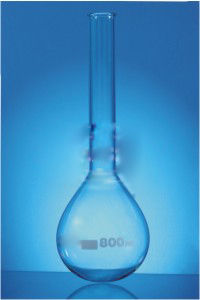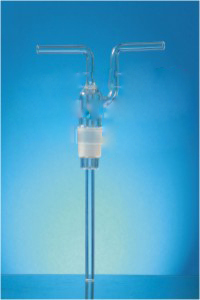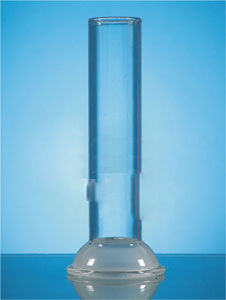Beaker, Low form
Beaker, Low form Specification
- Shape
- Low Form (Cylindrical, Graduated)
- Temperature Resistance
- Up to 400C
- Control Type
- Manual
- Glass Type
- Borosilicate Glass
- Features
- High Quality
- Type
- Beaker, Low Form
- Dimension (L*W*H)
- Not Specified
- Equipment Type
- Laboratory Glassware
- Equipment Materials
- Plastic & Glass
- Material
- Plastic & Glass
- Application
- Laboratory
- Capacity (Ltr)
- Not Specified
About Beaker, Low form
Designed as per ISO and DIN norms, Beaker Low Form can be availed in different capacity, diameter and height based choices. Made of borosilicate glass, its capacity ranges between 5 ml to 2000 ml. Its dimension ranges between 22 mm to 132 mm. Its minimum and maximum height is 30 mm and 185 mm respectively. Offered Beaker Low Form has been designed by seasoned personnel by using advanced technology. Standard of this product has been verified on the basis of its longevity, resistance attributes and density.
| Beaker, Low form | ||||||||||||||||||||||||||||||||||||||||||||||||||||||||||||||||||||||||||
|
|
Clear Measurement and Handling Efficiency
Graduated markings on this beaker allow accurate volume readings for all liquid measurement tasks. The low form, cylindrical shape provides stability during mixing and heating, while the pouring spout ensures spill-free transfers. Its stackable feature makes storage simple and efficient, saving space in busy laboratory environments.
Exceptional Durability and Chemical Resistance
Crafted from borosilicate glass and premium plastic, this beaker withstands harsh chemicals and high temperatures up to 400C. Suitable for repeated autoclaving and versatile lab processes, users benefit from its consistent performance, reliability, and long lifespan during various demanding applications.
FAQs of Beaker, Low form:
Q: How should I use the low form beaker for liquid measurement and mixing?
A: You should fill the beaker to the desired graduation marking for precise measurement. The cylindrical low form design is ideal for mixing solutions with a stirring rod, and the pouring spout helps transfer liquids accurately without spills.Q: What are the benefits of using a beaker made from borosilicate glass and plastic materials?
A: Borosilicate glass and plastic offer high temperature resistance up to 400C and strong chemical durability, allowing safe use with reactive substances and repeated sterilization by autoclaving. The combined materials also keep the beaker lightweight and easy to handle.Q: When can this beaker be autoclaved, and how does it affect its longevity?
A: The beaker can be autoclaved before and after each use to maintain laboratory hygiene. Its high-quality materials allow for repeated autoclaving without compromising the transparency or structural integrity, extending its service life.Q: Where is this laboratory beaker typically used?
A: It is commonly used in research labs, educational institutions, chemical industries, and healthcare facilities across India, where accuracy in liquid measurement, mixing, and heating is essential.Q: What is the process for safely heating liquids in the beaker?
A: To heat liquids, place the beaker on a compatible lab heating surface. Its low form and cylindrical shape provide stability and even heat distribution, while borosilicate glass resists thermal shock. Always monitor the temperature to stay within the 400C resistance.Q: What makes these beakers suitable for stacking and storage?
A: Their uniform shape and lightweight design promote easy stackability, allowing multiple beakers to be stored conveniently in limited lab spaces, helping maintain order and accessibility.

Price:
- 50
- 100
- 200
- 250
- 500
- 1000+
More Products in LABORATORY GLASSWARE Category
Flasks, Kjeldhal Round Bottom Long Neck
Material : Glass
Type : Other, Kjeldahl flask
Equipment Materials : Glass
Shape : Round bottom long neck
Application : Laboratory use Kjeldahl analysis
Glass Type : Borosilicate glass
Head for Gas Bottles
Material : Brass/Steel/Aluminum
Type : Other, Head for Gas Bottles
Equipment Materials : Metal Alloy, Brass, Stainless Steel
Shape : Cylindrical/Fitting Head
Application : Used for gas bottle output regulation or connection
Spherical Joint: Cup
Material : Glass
Type : Other, Joint
Equipment Materials : Glass
Shape : Cylindrical with spherical joint cup
Application : Laboratory equipment
Glass Type : Borosilicate glass
Flasks, Buckner Filtration Bolt Neck
Material : Glass
Type : Other, Buckner Flask
Equipment Materials : Borosilicate glass
Shape : Coneshaped with bolt neck and side arm
Application : Filtration processes in laboratory settings
Glass Type : Borosilicate
GST : 06ACOPS0805K1ZD
|
 |
SINGHLA SCIENTIFIC INDUSTRIES
All Rights Reserved.(Terms of Use) Developed and Managed by Infocom Network Private Limited. |


 Send Inquiry
Send Inquiry





